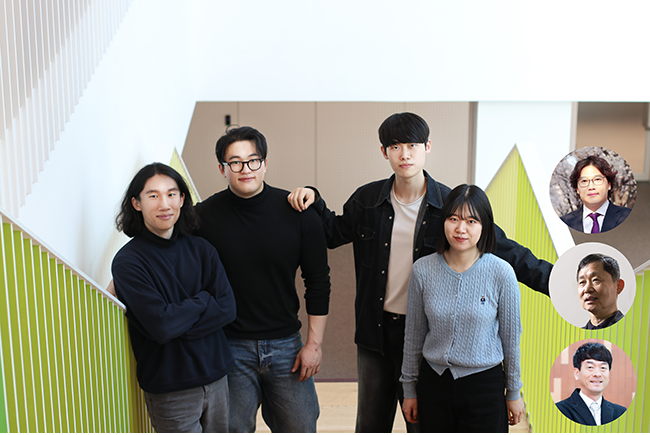
Center: From left, Hyeongwoo Lee, Taeyoung Moon, Huitae Joo, and Yeonjeong Koo at POSTECH. Right: From the top, Professor Kyoung-Duck Park at POSTECH and Professor Dai-Sik Kim and Professor Yung Doug Suh at UNIST. Image Credit: Zhang Qipengcia
With the developed technology, it is possible to rapidly test various types of materials, including infectious disease viruses, using only a single nano-spectroscopic sensor to find molecular fingerprints.
The emergence of pandemic epidemics such as COVID-19 has underscored the need for rapid and precise analytical methods to prepare for potential future virus outbreaks.
Raman spectroscopy, when used with gold nanostructures, provides detailed insights into the internal structure and chemical properties of materials by analyzing unique molecular vibrations known as 'molecular fingerprints' with exceptional sensitivity. Consequently, this technique could play a vital role in the rapid identification of viral infections.
However, traditional high-sensitivity Raman spectroscopy sensors detect just one type of virus on a single device, limiting productivity, detection speed, and cost in clinical applications.
To this end, the research team successfully created a one-dimensional structure at the millimeter scale, which features gold nanogaps that tightly accommodate only a single molecule. This breakthrough enables large-area, high-sensitivity Raman spectroscopic sensing. Additionally, they effectively integrated flexible materials into the substrate of the gold nanogap spectroscopic sensor.
Moreover, the team developed a source technology for a broadband active nano-spectral sensor. This innovation allows for the tailored detection of specific substances, including viruses, by adjusting the nanogap width to match the size and type of the targeted materials.
They also increased the sensor’s sensitivity and controllability by merging adaptive optics technologies utilized in domains such as space optics and the James Webb Telescope.
Furthermore, the team developed a conceptual model to expand the one-dimensional structure into a two-dimensional spectroscopic sensor. This model theoretically confirms that it could amplify Raman spectroscopic signals by up to several billion times. This significant enhancement means that it would be possible to confirm the presence of viruses in real-time within seconds—a dramatic improvement over the days previously required for verification.
The study team’s results, which are now undergoing patent approval, are likely to be used to provide prompt reaction through high-sensitivity real-time testing in the case of unforeseen infectious diseases such as COVID-19, preventing indiscriminate spread.
This not only advances basic scientific research in identifying unique properties of materials from molecules to viruses but also facilitates practical applications, enabling rapid detection of a broad spectrum of emerging viruses using a single, tailored sensor.
Taeyoung Moon, Study Lead Author and Graduate Student, Pohang University of Science and Technology
The collaborative research was conducted jointly by Professor Dai-Sik Kim’s team from the Department of Physics at UNIST and Professor Yung Doug Suh’s team from the Department of Chemistry at UNIST, where Professor Suh also serves as Deputy Director of the Center for Multidimensional Carbon Materials at the Institute for Basic Science (IBS). Additionally, Yeonjeong Koo, Mingu Kang, and Hyeongwoo Lee from the Department of Physics at POSTECH conducted the measurements.
Journal Reference:
Moon, T., et. al. (2024) Adaptive Gap-Tunable Surface-Enhanced Raman Spectroscopy. Nano Letters. doi:10.1021/acs.nanolett.4c00289